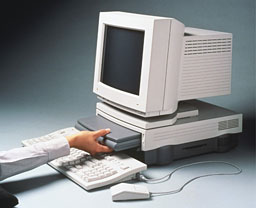Imagine, if you will. You return home from class or work. You pull
your MacBook Air from its
bag and slide it into the MacDock sitting on your desk. Then you pull
your iPhone from your pocket and slide it onto your iPod dock. The
iPhone automatically synchs to your now fully featured MacBook Duo.
iTunes loads and synchs the TV shows and movies that you downloaded on
the Apple TV 2 that's connected to the HDTV in your living room. You
backup and sync the files you were working on all day to the Time
Capsule you have connected to your broadband modem.
You're now sitting at the center of the digital hub of your life,
powered by Apple.
Three of the four missing pieces of this Apple "digital life"
arrived with Steve Jobs' keynote
at Macworld Expo 2008. The announcements of upgraded Apple TV software,
the new MacBook Air, and Time Capsule filled in those three missing
pieces. All that is left is information about - and the eventual
release of - the MacDock.
Looking Back

PowerBook Duo in the Apple DuoDock.
The path of product releases and design ideas leading to this all
began 16 years ago with the introduction of the PowerBook Duo 210 and the DuoDock in October 1992. The concept of
having a portable system that you could transform into a full desktop
computer, just by sliding it into a dock, was light-years ahead of any
laptop docking system available at the time.
The PowerBook Duos were designed with the idea that the people
actually using them were more interested in doing their work than
moving the files between computers. These subnotebooks lacked any
removable drives and did away with all but the most basic ports: power
and fax/modem.
What the Duos themselves lacked, the DuoDocks made up completely.
The Docks included a slot that the Duo slid and locked into, slots for
extra system and video RAM on top of that already in the Duo, a 68882
FPU, a floppy drive, two NuBus slots, room for a second hard drive, and
all the external ports you would expect on any desktop Mac.
The entire Duo system offered a way to have your cake and eat it
too. When away from your desk, you had a fully functional Mac laptop.
When back home or in your office, you had a desktop Mac comparable to
any other at the time.
The line eventually moved to the 68LC040 processor with the 280 and then the PowerPC 603e with the
2300. The line was
discontinued in early 1997. The Duos lasted for five years, established
a new way of thinking about portable computing, and set the standard
for what a docking portable system should be.
Looking Forward
Fast forward 16 years to January 15, 2008. Steve Jobs announces the
MacBook Air. In every respect, it is a modern-day Duo. It lacks any
removable drives and all but the most basic ports: power, USB,
mini-DVI, and a headphone jack.
However, unlike the sneakernet and slow-speed networking days of the
original Duos, the framework for a drive-less and port-less laptop is
finally available. With the prevalence of WiFi for networking,
Bluetooth for device connectivity, and wireless networks virtually
everywhere you go, the lack of physical connectivity is almost
inconsequential. Optical drive needs can be met either with the
external USB SuperDrive or Apple's new Remote Disc software.
The second half of the modern Duo system, the MacDock was patented
by Apple on January 3, 2008. The patent application describes exactly
what a modern DuoDock should be; an iMac with no guts. The drawings in
the application show an iMac-like case with a cutout on the side for
sliding in a laptop the size of the MacBook Air. As long as Apple
releases this MacDock within the year and includes (at the least) a
second hard drive and a built-in optical drive along with the missing
ports, the Dock will totally complete the modern Duo system.
A lot has been said of the usefulness or niche marketability of the
Air. They say a cheaper MacBook would do better for general use, or
that for just a few hundred dollars more, they could have an even more
capable MacBook Pro. What most of those voices seem to be forgetting is
that, like the original Duo, the Air is perfect for the groups that
would be buying it; students, business travelers, and journalists.
Basically, anyone who absolutely requires portability but who doesn't
need a full package while they are away from their desks.
The Air is a 'subnotebook' or 'ultra-portable'. It has all the parts
it needs to fill that role, and none of the parts it doesn't.
I have been waiting years for a return to the Duo paradigm. Before
my school newspaper upgraded to PowerBook 1400s, we had Duos. I fell in
love with them then and have wanted a system like that for my personal
use.
When I'm away from home, I just need something I can write with,
watch movies and listen to music on, and surf the Web. The Air is light
enough that I can carry it for long periods of time without straining
myself, yet powerful enough that I can do everything I need a portable
computer for.
Eventually Apple will release the MacDock that I'm waiting for, and
I'll have the complete package. A super-light and thin laptop, and a
nice big monitor with a full keyboard and real mouse . . .
all while never having to worry about the hassles of synching between
two computers. 
Robert Alpizar is a longtime Mac user.



